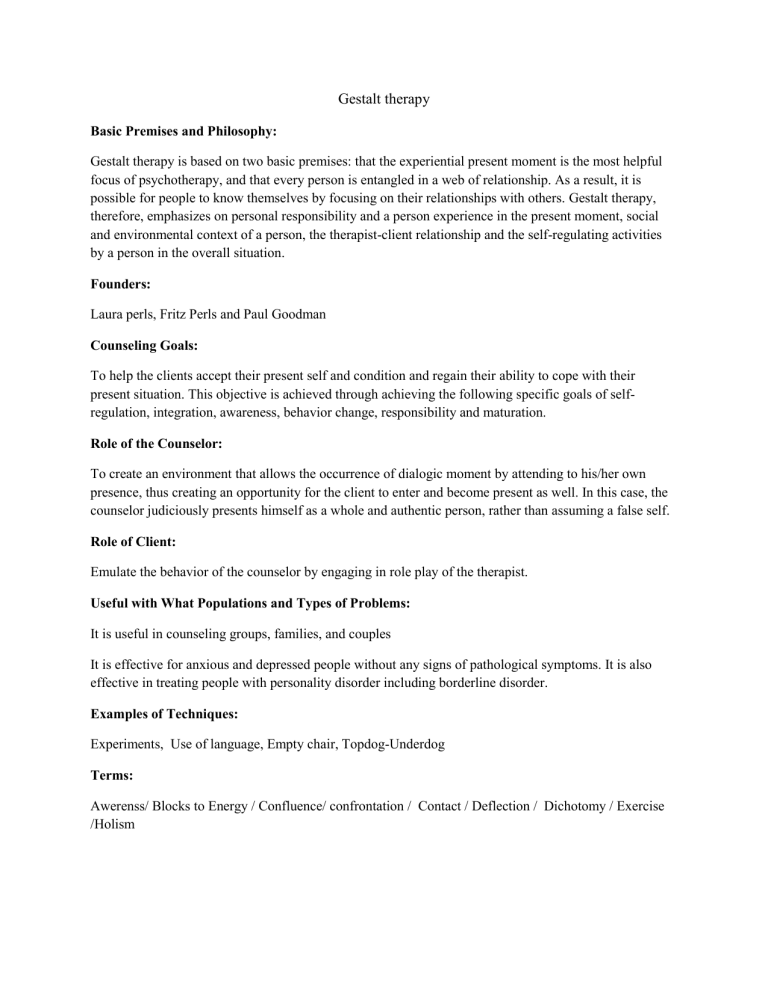Gestalt Therapy: Principles, Techniques, and Applications
advertisement

Gestalt therapy Basic Premises and Philosophy: Gestalt therapy is based on two basic premises: that the experiential present moment is the most helpful focus of psychotherapy, and that every person is entangled in a web of relationship. As a result, it is possible for people to know themselves by focusing on their relationships with others. Gestalt therapy, therefore, emphasizes on personal responsibility and a person experience in the present moment, social and environmental context of a person, the therapist-client relationship and the self-regulating activities by a person in the overall situation. Founders: Laura perls, Fritz Perls and Paul Goodman Counseling Goals: To help the clients accept their present self and condition and regain their ability to cope with their present situation. This objective is achieved through achieving the following specific goals of selfregulation, integration, awareness, behavior change, responsibility and maturation. Role of the Counselor: To create an environment that allows the occurrence of dialogic moment by attending to his/her own presence, thus creating an opportunity for the client to enter and become present as well. In this case, the counselor judiciously presents himself as a whole and authentic person, rather than assuming a false self. Role of Client: Emulate the behavior of the counselor by engaging in role play of the therapist. Useful with What Populations and Types of Problems: It is useful in counseling groups, families, and couples It is effective for anxious and depressed people without any signs of pathological symptoms. It is also effective in treating people with personality disorder including borderline disorder. Examples of Techniques: Experiments, Use of language, Empty chair, Topdog-Underdog Terms: Awerenss/ Blocks to Energy / Confluence/ confrontation / Contact / Deflection / Dichotomy / Exercise /Holism Behavior Therapy Basic Premises and Philosophy: Behavior therapy is based on the assumption that behavior associated with a psychological problems develops through the same learning processes affecting the development of other behaviors. As a result, the behaviorist’s therapist focus on the way the personal problem was developed through learning. According to this therapy, since all behavior are learned, even the unhealthy behaviors can be changed through learning. Founders: Joseph wolpe and Hans Eysenck Counseling Goals: -To enable the client engage in many positive and socially motivating activities. -To identify and assist in changing potentially unhealthy and self-destructive behavior. Role of the Counselor: The role of counselor is to identify and reinforce desirable behavior as well as stop destructive behavior. Select the best technique for counseling that best help solve the problem. Role of Client: Avoid engaging in behavior that is deemed destructive and embrace desirable behavior. Learn new behaviors that will help to counter the destructive psychological behavior. Useful with What Populations and Types of Problems: Behavior therapy is suitable for children and adult, who experiencing psychological problems such as anger issues, anxiety, panic disorders, and depression. It is also used to treat disorders and conditions such as eating disorder, bipolar disorder, self-harm and substance abuse. Examples of Techniques: Systematic desensitization / flooding / aversion therapy / modeling / social skills training / virtual reality exposure / behavioral rehearsal / and homework. Terms: ABC model / Acceptance / Anger Management training / Antecedent events / Assertion training / assessment interview / Basic I.D / Assessment interview / Applied behavior analysis / Cognitive Behavior Therapy Basic Premises and Philosophy: Cognitive behavior therapy is based on the premises that people’s feelings and thoughts play fundamental roles in their behavior. It is a combination of behavioral therapy and psychotherapy. From these two therapies, CBT focuses on the importance of the personal meaning that people place on things and how their thinking pattern began from their childhood. As a result it concentrates of the relationships between people problems, behavior, and thoughts. Founders: Aaron Beck Counseling Goals: The aim of CBT is to change the behavior or thinking patters of people who are experiencing difficulties so as to change the way they feel. To achieve its goals aims at focusing on concentrating on images, thoughts, attitudes and beliefs that patients held in their cognitive processes and how such processes relate to ways people behave. Role of the Counselor: Assist the client to identify behaviors that are unproductive or undesirable to the client and then together with him/her to identify and test new beneficial behavior. The role of the counselor is to listen, teach, and encourage the client. They search of the strengths of the client and use those strengths to teach him/her what to do without telling him/her. Role of Client: The role of the client is to show concern, learn new behaviors and implement the learning. Useful with What Populations and Types of Problems: CBT is critical in treating adult individual patients. In some cases, however, it can be used in group counseling. CBT is effective in treating clients with the following problems: chronic pain, depression, anger management, mood swings, phobias, sleep problems, and eating problems among others. Examples of Techniques: Journaling / mindfulness / challenging beliefs / relaxation / social, physical, and thinking exercises. Terms: CBT/ trigger, reality testing / step 1-8 / A- E / Cognitive distortions / mind reading / fortune telling / should & must / personalization and blame / labeling Reality Therapy Basic Premises and Philosophy: The therapy is based on the premise that any people with psychological conditions are suffering from socially universal conditions that are not mental illness. According to Glasser human beings have four basic psychological needs that must be satisfied for them to function effectively. These needs include: power, freedom, love and belonging, and survival. When these needs are not met, the behaviors of an individual shifts from the norm. Founders: William Glasser Counseling Goals: The goal of reality therapy are to help patients learn how to establish and strengthen positive relationships with others. Besides, it aims at enabling patients to take greater control over their lives by making good decisions. Role of the Counselor: The role of a counselor is to create a connection with the patient. This therapist then uses the established bonding to facilitate the healing process. When the bonding between the counselor and the patient is stable, it helps the patient form a positive and fulfilling connection with other people Role of Client: The role of the client is to learn different strategies for establishing and strengthening relationships with other people even in the absence of the therapist. Useful with What Populations and Types of Problems: Reality therapy is effective among individual, parent-child, and family counseling. The therapy is normally in people with behavioral and emotional disturbances, child-hood obesity, and post-traumatic stress disorder. Examples of Techniques: Terms: Autonomy / commitment / involvement / control theory / perceived world / positive addiction / responsibility / success identify / picture album / paining behaviors. Feminist Therapy Basic Premises and Philosophy: Feminist therapy is based on the assumption that most people seeking counseling are women yet the origins of most psychological theories are from men. According to this therapy, the reason why women are the majority patient of counseling, it is because they are the most disadvantaged because of sex, religion, age, ethnicity, sexuality, gender, and race. Founders: Feminist movements of 1960 Counseling Goals: The goal of feminist theory is to empower patient and help them discover different ways of breaking away from stereotypes and molds of traditional roles played by women that may be the cause of their problem. As a result, the therapy aims at equal mutual relationships of support and care among the patients. Role of the Counselor: The aim of the counselor is to empower patients in areas such as self-esteem, assertiveness, relationships, and communication by helping them to see effects of gender issues in their lives. A task counselor in this case is to assist the client explore and understand the causes of unhappiness and dysfunction and then develop techniques for solving these problems. Role of Client: Useful with What Populations and Types of Problems: Feminist theory is most effective among women; however, it can also be in families, people, and children of any gender. Feminist therapy is most suitable in situations where psychological conditions such as depression and eating disorder, are as a result of problematic attitude towards gender thus resulting to oppression or discrimination. Examples of Techniques: Self-disclosure / Gender-role analysis and intervention / power analysis / Reframing / Social action Terms: Androcentric / ethnocentrism / Deterministic / Gendercentric / Gender-fair approaches / Gender-Neutral Theory / Gender-role intervention / Flexible-Multicultural Perspective Basic Premises and Philosophy: Founders: Counseling Goals: Role of the Counselor: Role of Client: Useful with What Populations and Types of Problems: Examples of Techniques: Terms:

